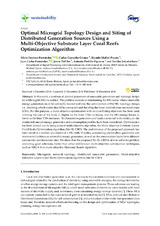Optimal Microgrid Topology Design and Siting of Distributed Generation Sources Using a Multi-Objective Substrate Layer Coral Reefs Optimization Algorithm
Autor
Jiménez-Fernández, Silvia
Camacho-Gómez, Carlos
Mallol-Poyato, Ricardo
Fernández, Juan Carlos
Ser, Javier del
Portilla-Figueras, Antonio
Salcedo Sanz, S.
Editor
MDPIFecha
2019Materia
MicrogridsNetwork topology
Distributed renewable generation
Multi-objective Substrate Layers Coral Reefs Optimization algorithm (Mo-SL-CRO)
METS:
Mostrar el registro METSPREMIS:
Mostrar el registro PREMISMetadatos
Mostrar el registro completo del ítemResumen
In this work, a problem of optimal placement of renewable generation and topology design for a Microgrid (MG) is tackled. The problem consists of determining the MG nodes where renewable energy generators must be optimally located and also the optimization of the MG topology design, i.e., deciding which nodes should be connected and deciding the lines’ optimal cross-sectional areas (CSA). For this purpose, a multi-objective optimization with two conflicting objectives has been used, utilizing the cost of the lines, C, higher as the lines’ CSA increases, and the MG energy losses, E, lower as the lines’ CSA increases. To characterize generators and loads connected to the nodes, on-site monitored annual energy generation and consumption profiles have been considered. Optimization has been carried out by using a novel multi-objective algorithm, the Multi-objective Substrate Layers Coral Reefs Optimization algorithm (Mo-SL-CRO). The performance of the proposed approach has been tested in a realistic simulation of a MG with 12 nodes, considering photovoltaic generators and micro-wind turbines as renewable energy generators, as well as the consumption loads from different commercial and industrial sites. We show that the proposed Mo-SL-CRO is able to solve the problem providing good solutions, better than other well-known multi-objective optimization techniques, such as NSGA-II or multi-objective Harmony Search algorithm.

